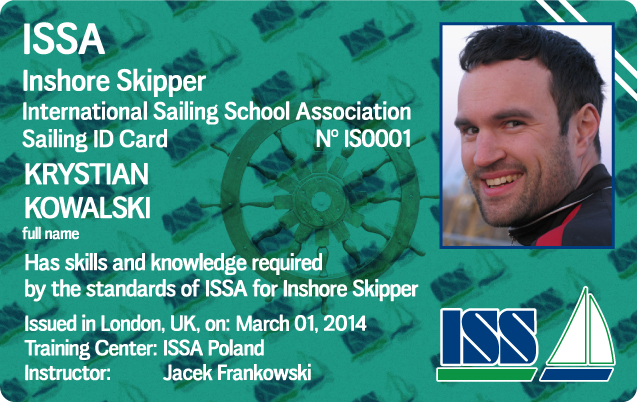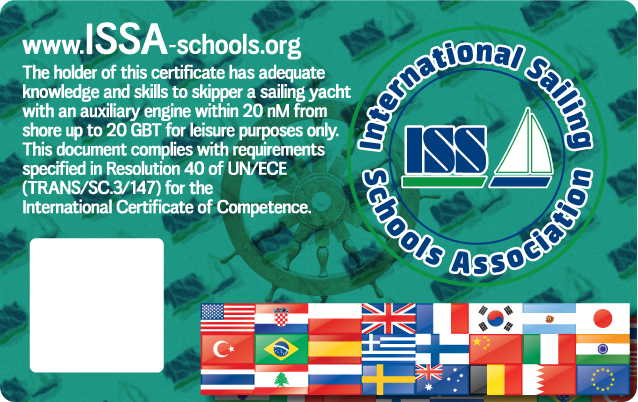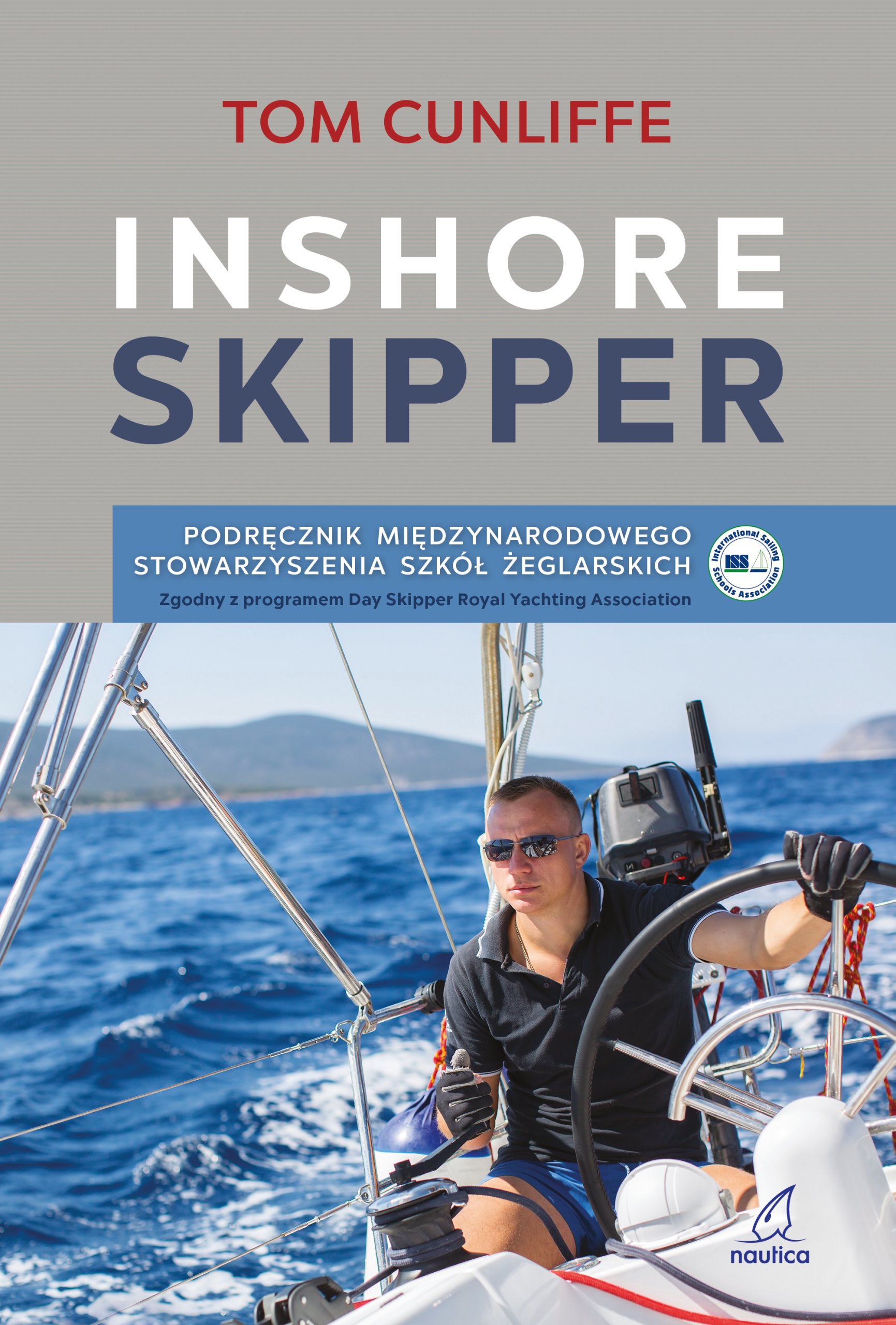

ISSA- INSHORE SKIPPER
Wymagane doświadczenie przed kursem:
Minimum 25 godz rejsu morskiego w charakterze członka załogi.
Wymagane dodatkowe uprawnienia przed kursem:
Żadne. Pamiętaj aby wyczarterować jacht należy posiadać w załodze osobę lub posiadać własne, udokumentowane umiejętności/kompetencje do obsługi radia VHF (SRC). Polecamy nasze szkolenia w tym zakresie
Minimalny wiek:
16 lat
Długość szkolenia:
50 kurso-godzin realizowane w trakcie rejsu morskiego.
Zalecany podręcznik:
Inhore Skipper Tom Cuniffe
poprzez kliknięcie w okładkę nastąpi przekierowanie do wydawnictwa z możliwością zakupu on-line
Materiały (student book) dla kursanta:
w formacie PDF do samodzielnego wydruku ISSA InSkipper StudBook
Wymagane umiejętności i wiedza (program szkolenia) dla pozyskania certyfikatu Inshore Skipper
Yacht's construction
- Knows the basic parts of yacht and what are the designed for:
- Cockpit;
- Bildge;
- Heads;
- Galley;
- Bow;
- Stern, aft, etc.
- Can operate elementary yacht's systems:
- Toilet;
- Gass oven;
- Sink;
- Shower;
- Can fill up the water and diesel tanks;
- Can operate the inboard engine;
- Start is;
- Switch it off;
- Check operation of cooling system;
- Check oil level;
- Top up engine oil;
- Check cooling fluid level;
- Top up cooling fluid level;
- Control the tension of V-belt on engine;
- Find bottom valves;
- Recognize the breakdown of impeller in cooling system and possibly replace it;
- Check whether alternator is charging batteries when engine is working.
- Knows elementary equipment of yacht:
- Boom;
- Mast (with various methods of sail reefing);
- Rigging;
- Haulyards;
- Echosounder (location, operation, typical errors);
- Log;
- Steering system;
Can name the points of sail in relation to wind
Operating sail sheets and haulyards.
- Can:
- Manage crew to set and bring down the sails;
- Manage the crew to reef down and shake off the reefs;
- Adjust sails depending on the point of sails;
- Make a tack;
- Make a gybe.
Line and spring handling
- Can combine two lines of the same and different diameter;
- Can make:
- Bowline;
- Fast a line on a cleat;
- Fishermen's bend;
- Coil mooring lines;
- Can:
- Pass, take, make fast on cleat, let go mooring lines;
- Throw mooring lines;
- Describe different ways of taking a mooring.
Handling fenders.
- Can:
- Fix the fenders using adequate knots;
- Effectively apply the manouvring fender;
Operating the anchor.
- Can:
- Prepare the ancher for weighing (switches and controls);
- Operate the windlass (control the letting out and pulling in of the chain);
- Select safe location for staying at anchor;
- Apply rules for safe anchoring (4xdepth, anchor alarm/watch);
- Distinguish different types of anchors and their characteristics.
Handling the dinghy.
- Can:
- Inflate dinghy, take it off the deck and put it back on the deck;
- Secure the dinghy to the yachts;
- Paddle;
- Secure the dinghy on the deck of the yacht;
- Install the outboard engine on the yacht (for storage) and on the dinghy (for work);
- Connect the fuel system to the outboard engine;
- Start and switch off the outboard engine.
Safety.
- Can:
- Perform the safety briefing:
- Under deck:
- Gas system;
- Toilet operation;
- Fire fighting equipment;
- Water supply system;
- Electric system.
- On deck:
- How to move on deck;
- How to apply personnal safety equipment (harness, jackstay, etc.);
- Apply distress singalling equipment (pirotechnics, flags, etc.);
- Liferaft;
- Different methods to send distress signal;
- Make a distress call with help of VHF;
- Knows procedures to be applied in restricted visibility;
- Basic knowledge about SAR procedures (RIB, helicopter);
- First Aid Kit (location and content).
- Under deck:
- Perform the safety briefing:
Handling yacht under power.
- Can:
- Manouver a yacht under power;
- Approach a MOB;
- Take a berth/leave a berth (longside, stern-to, bow-to);
- Weigh anchor.
Handling yacht under sails.
- Can:
- Heave-to;
- Approach MOB – as emergency manouver;
- Approach a bouy/ weigh anchor – as emergency manouver;
International Rules for Preventing Collisions at Sea
- Knows the navigation shapes and lights:
- Vessel not under command;
- Vessel restricted in ability to manouver;
- Vessel engaged in fishing;
- Vessel aground;
- Pitol vessel;
- Towing set
- Sailing yacht;
- Power driven vessel;
- Knows the vessels' priority at sea;
- Knows how to proceed in a „close encounter” situation;
- Is familiar and complies with the requiremet for continues observation;
- Is familiar with other legal obligations of a skipper and crew;
- Is familiar with and understands after-collission rules applicable at sea.
Navigational Aids
- Knows, understands and is able to recognize latteral and smaller channel marks at day time in system IALA A and B;
- Knows, understands and is able to recognize cardinal marks and other navigational marks (safe water mark, isolated danger mark) at day time;
- Is able to use the list of marks and symbols used on charts (eg. Chart 5011);
- Is able to apply navigational publications when planning a port's entry (pilot books, almanachs, navigational plans);
- Knows and can recognize light characteristics of Lighthouses/navigational marks.
Terrestrial navigation
- Knows and understands the basic terms from geography:
- Latitude;
- Longitude;
- Magnetic pole;
- Gegraphic pole;
- Earth's magnetic field;
- Knows the basic types of sea charts, their construction and application:
- Mercator's projection chart (how is it constructed, spreading of parallels, construction parallel)
- Passage charts, coastal charts, plans;
- Can read elementary information from a chart that is crutial for safe sailing:
- Depths;
- Distance;
- Navigational obstacles
- Navigational marks;
- Can read charts/ plot latitude and longitude;
- Knows and understands the phenomenon of Earth's magnetism, variation and deviation;
- Can use a compass;
- Can calculate, set, read and plot courses on a chart with respect of variation, deviation and leeway;
- Can plot yacht's position using bearing lines;
- Can plot yacht's position using the maintained course, distance ran and estimated leeway;
- Can make use of various bearing lines;
- Has general information about tides and tide-related dangers.
Eletronic-based navigation
- Knows how the GPS system works;
- Can enable and check the elementary settings of GPS and plotter;
- Can set and read adequate course on GPS;
- Can plot a position on a chart taken from a GPS;
- Knows what is AIS, ARPA, VTS.
Meteorology
- Knows the Beaufort scale and its meaning for small craft;
- Knows sources of meteo information and how to use them;
- Has the basic knowledge about high, low pressure areas, fronts;
- Can recognize cumulonimbus clouds;
- Understands meteo messages (including those broadcast by radio coastal stations)
- Can take meteo factors into consideration when planning a passage in a coastal zone:
- Has the habit not to leave harbour without valid weather forecast.
Other
- Environmental friendly approach and respect to other yachtsmen and women;
- Knows and applies basic pro-environmental rules;
Kursy indywidualne
Cena: 1250zł/ 299 eur + udział w min. 3 rejsach. Terminy dowolne
Cena certyfikatu - 350,00 zł/85 eur
UWAGA - aby wyczarterować jacht morski potrzebna jest w załodze osoba z uprawnieniami do obsługi radia VHF (SRC). Zalecamy aby skipper taką wiedzę również posiadał. Skorzystaj ze szkolenia ISSA VHF SRC
Kursy grupowe/intensywnie - 1 tydzień:
SPYTAJ mailowo o najbliższy termin.
info@travel-yachting.pl
Cena kurs-rejsu - 1 675,00 zł/400 eur
* cena nie obejmuje składki do kasy jachtowej na wyżywienie, opłaty portowe, paliwo. Kapitan nie partycypuje do kasy jkachtowej - ok.100 eur
Cena certyfikatu - 350,00 zł/85 eur
UWAGA - aby wyczarterować jacht morski potrzebna jest w załodze osoba z uprawnieniami do obsługi radia VHF (SRC). Zalecamy aby skipper taką wiedzę również posiadał. Skorzystaj ze szkolenia ISSA VHF SRC
UWAGA - zgłoszenie na kurso-rejs proszę realizować poprzez ww. strony rejsów (linki) z adnotacją w uwagach - szkolenie ISSA INSHORE SKIPPER.
Ilość mieść ograniczona. Decyduje kolejność zgłoszeń
Pytania?
+48604467409


